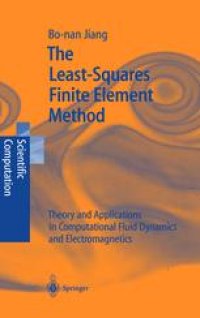
Ebook: The Least-Squares Finite Element Method: Theory and Applications in Computational Fluid Dynamics and Electromagnetics
Author: Dr. Bo-nan Jiang (auth.)
- Tags: Numerical and Computational Physics, Calculus of Variations and Optimal Control, Optimization, Computational Science and Engineering, Optics and Electrodynamics, Fluid- and Aerodynamics
- Series: Scientific Computation
- Year: 1998
- Publisher: Springer-Verlag Berlin Heidelberg
- Edition: 1
- Language: English
- pdf
This is the first book devoted to the least-squares finite element method (LSFEM), which is a simple, efficient and robust technique for the numerical solution of partial differential equations. The book demonstrates that the LSFEM can solve a broad range of problems in fluid dynamics and electromagnetics with only one mathematical/computational formulation. The book shows that commonly adopted special treatments in computational fluid dynamics and computational electromagnetics, such as upwinding, numerical dissipation, staggered grid, non-equal-order elements, operator splitting and preconditioning, edge elements, vector potential, and so on, are unnecessary.
This book introduces the basic theory of the least-squares method for first-order PDE systems, particularly the div-curl system and the div-curl-grad system. It is applied to the study of permissible boundary conditions for the incompressible Navier--Stokes equations, to show that the divergence equations in the Maxwell equations are not redundant, and to derive equivalent second-order versions of the Navier--Stokes equations and the Maxwell equations. This book covers diverse applications such as incompressible viscous flows, rotational inviscid flows, low- or high-Mach-number compressible flows, two-fluid flows, convective flows, and scattering waves.
This is the first book devoted to the least-squares finite element method (LSFEM), which is a simple, efficient and robust technique for the numerical solution of partial differential equations. The book demonstrates that the LSFEM can solve a broad range of problems in fluid dynamics and electromagnetics with only one mathematical/computational formulation. The book shows that commonly adopted special treatments in computational fluid dynamics and computational electromagnetics, such as upwinding, numerical dissipation, staggered grid, non-equal-order elements, operator splitting and preconditioning, edge elements, vector potential, and so on, are unnecessary.
This book introduces the basic theory of the least-squares method for first-order PDE systems, particularly the div-curl system and the div-curl-grad system. It is applied to the study of permissible boundary conditions for the incompressible Navier--Stokes equations, to show that the divergence equations in the Maxwell equations are not redundant, and to derive equivalent second-order versions of the Navier--Stokes equations and the Maxwell equations. This book covers diverse applications such as incompressible viscous flows, rotational inviscid flows, low- or high-Mach-number compressible flows, two-fluid flows, convective flows, and scattering waves.
This is the first book devoted to the least-squares finite element method (LSFEM), which is a simple, efficient and robust technique for the numerical solution of partial differential equations. The book demonstrates that the LSFEM can solve a broad range of problems in fluid dynamics and electromagnetics with only one mathematical/computational formulation. The book shows that commonly adopted special treatments in computational fluid dynamics and computational electromagnetics, such as upwinding, numerical dissipation, staggered grid, non-equal-order elements, operator splitting and preconditioning, edge elements, vector potential, and so on, are unnecessary.
This book introduces the basic theory of the least-squares method for first-order PDE systems, particularly the div-curl system and the div-curl-grad system. It is applied to the study of permissible boundary conditions for the incompressible Navier--Stokes equations, to show that the divergence equations in the Maxwell equations are not redundant, and to derive equivalent second-order versions of the Navier--Stokes equations and the Maxwell equations. This book covers diverse applications such as incompressible viscous flows, rotational inviscid flows, low- or high-Mach-number compressible flows, two-fluid flows, convective flows, and scattering waves.
Content:
Front Matter....Pages I-XVI
Front Matter....Pages 1-1
Introduction....Pages 3-10
First-Order Scalar Equation in One Dimension....Pages 11-30
First-Order System in One Dimension....Pages 31-44
Front Matter....Pages 45-45
Basis of LSFEM....Pages 47-79
Div—Curl System....Pages 81-95
Div—Curl—Grad System....Pages 97-112
Front Matter....Pages 113-113
Inviscid Irrotational Flows....Pages 115-128
Incompressible Viscous Flows....Pages 129-199
Convective Transport....Pages 201-240
Incompressible Inviscid Rotational Flows....Pages 241-257
Low-Speed Compressible Viscous Flows....Pages 259-284
Two-Fluid Flows....Pages 285-302
High-Speed Compressible Flows....Pages 303-328
Front Matter....Pages 329-329
Electromagnetics....Pages 331-382
Front Matter....Pages 383-383
The Element-by-Element Conjugate Gradient Method....Pages 385-396
Back Matter....Pages 397-418
This is the first book devoted to the least-squares finite element method (LSFEM), which is a simple, efficient and robust technique for the numerical solution of partial differential equations. The book demonstrates that the LSFEM can solve a broad range of problems in fluid dynamics and electromagnetics with only one mathematical/computational formulation. The book shows that commonly adopted special treatments in computational fluid dynamics and computational electromagnetics, such as upwinding, numerical dissipation, staggered grid, non-equal-order elements, operator splitting and preconditioning, edge elements, vector potential, and so on, are unnecessary.
This book introduces the basic theory of the least-squares method for first-order PDE systems, particularly the div-curl system and the div-curl-grad system. It is applied to the study of permissible boundary conditions for the incompressible Navier--Stokes equations, to show that the divergence equations in the Maxwell equations are not redundant, and to derive equivalent second-order versions of the Navier--Stokes equations and the Maxwell equations. This book covers diverse applications such as incompressible viscous flows, rotational inviscid flows, low- or high-Mach-number compressible flows, two-fluid flows, convective flows, and scattering waves.
Content:
Front Matter....Pages I-XVI
Front Matter....Pages 1-1
Introduction....Pages 3-10
First-Order Scalar Equation in One Dimension....Pages 11-30
First-Order System in One Dimension....Pages 31-44
Front Matter....Pages 45-45
Basis of LSFEM....Pages 47-79
Div—Curl System....Pages 81-95
Div—Curl—Grad System....Pages 97-112
Front Matter....Pages 113-113
Inviscid Irrotational Flows....Pages 115-128
Incompressible Viscous Flows....Pages 129-199
Convective Transport....Pages 201-240
Incompressible Inviscid Rotational Flows....Pages 241-257
Low-Speed Compressible Viscous Flows....Pages 259-284
Two-Fluid Flows....Pages 285-302
High-Speed Compressible Flows....Pages 303-328
Front Matter....Pages 329-329
Electromagnetics....Pages 331-382
Front Matter....Pages 383-383
The Element-by-Element Conjugate Gradient Method....Pages 385-396
Back Matter....Pages 397-418
....